 Every year it seams the world is under attack by some new virus, disease or a new Kardashian show that we have no cure for and will decimate all life, as we know it. With the potential of these catastrophic events on the horizon, I’m looking at you E!, I think about how the world would react and how quickly it could be saved. If you have ever had similar thoughts, fear not, we can attempt to save the world from this horror without ever having to leave our gaming tables. In Pandemic, designed by Matt Leacock, players take the roles of virus stopping specialist trying to save the world from four very annoying diseases. Pandemic is a co-op game that plays well for any combination of 2-4 players and plays in about 60 minutes.
Every year it seams the world is under attack by some new virus, disease or a new Kardashian show that we have no cure for and will decimate all life, as we know it. With the potential of these catastrophic events on the horizon, I’m looking at you E!, I think about how the world would react and how quickly it could be saved. If you have ever had similar thoughts, fear not, we can attempt to save the world from this horror without ever having to leave our gaming tables. In Pandemic, designed by Matt Leacock, players take the roles of virus stopping specialist trying to save the world from four very annoying diseases. Pandemic is a co-op game that plays well for any combination of 2-4 players and plays in about 60 minutes.
Game Overview:
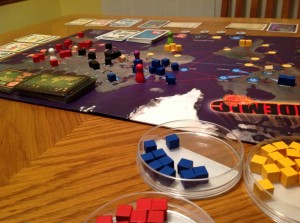
In the world of Pandemic, there are four different virus strains threatening to destroy life as we know it. The game starts with the players stationed at the CDC headquarters in Atlanta with nine of the major cities across the globe already having disease outbreaks. Players must move around the board and use their actions to cure these disease hotspots. To make matters worse, on each player’s turn diseases will start developing in other cities or possibly get worse in cities already infected. As time goes on, epidemics will sprout up and cause a once clean city to be overrun with the plague. Players have to balance keeping the illnesses under control with finding the cures before time runs out. If players are able to cure all 4 diseases in time and keep the outbreaks under control, they will win the game. If not, the world is destroyed and it will be all your fault.
Components:
For reference, I am reviewing the components for the 1st edition of the game. The game comes with a large board of the world with plenty of space on it for the player and city cards. The graphics on the board and its functionality are nothing amazing but they work. On the player cards, have the population of that city on it, country flag and its location on the world map. A nice added touch to something that could have been very bland. The one gripe I have about the components is the cubes used to represent the four diseases. They are just stock wooden cubes in four different colors. I have seen out in the interwebs replacement pieces for these cubes that all look like the different types of microorganisms we had to learn in high school. Would’ve been nice to have these pieces add to the thematic element to the game, and watch the different types of viruses expand over the world. A minor gripe but something that would have added value to the game.
How to Play:
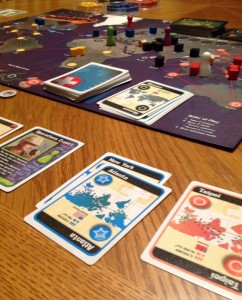
At the start of the game, each player takes a specific role. These roles have special abilities that allow each player to be unique and specialized to help in different situations that come up during the game. This adds tons of variety to the playing strategy and helps the replay value. It will take different strategies to win with different roles in the game. The players also select nine city cards to decide which cities will have disease cubes on them when the game begins. This gives outbreak areas for the players to deal with right off the bat. Each player turn has three distinct phases in their turn.
1. Take 4 player actions
This phase is where players are able to do a number of different things each costing one of their actions. First, there is movement around the board. This is done by either moving a player piece between cities adjacent to one another or playing player cards to move to specific cities. This allows players to be able to move around quickly to deal with new problem areas as they come up in the game. They can also give cards to other players, treat diseases by removing cubes that have accumulated in a city, even find a cure of a disease if they have enough matching color player cards. These actions allow players to hold down the virus threat while they attempt to find a cure. Players will have difficult decisions to make during their turn on how to use their limited actions. The 4 action allotment never seems to be enough.
2. Draw 2 cards and add to their hand
In the player deck, there is a variety of cards. There are city cards. These are what you collect to cure diseases. There are also special event cards mixed into this deck that give players unique one time use abilities during the game. The game does set a limit of a seven card hand limit which forces players to make difficult decisions on what cards to keep throughout the game.
The cards also represent a time element in the game. If players are not able to cure all four diseases by the time the player deck runs out of cards, they lose the game. Players must be as efficient as possible and move quickly to cure and contain viruses through the game.
There is another type of card in this deck, the dreaded EPIDEMIC card. These cards are the bane of all players. Every time one of these cards is drawn, a city from the bottom of the city deck is drawn and that city gains three infection cubes. That card, as well as any other cards in the discard pile, are reshuffled and placed at the top of the city deck. This means that cities that have been drawn recently could be drawn again very quickly. This can cause the cities to become even more infected and places that the players have cleaned out to become infected once again.
3. Playing the role of the infector
At this point of a players turn, they will look at the current infection rate. This rate represents how many cities will be drawn on each players turn. This number goes up as epidemic cards are drawn. When a city card is drawn during this phase, that city receives one cube to represent that the infection has gotten worse. If there are no more cubes of that color to play from the supply, the players lose. This game mechanic forces players to take care of every type of disease as they appear and not just focus on one disease at a time. If they have placed more than three cubes on a city, bad things happen. First, an outbreak has occurred. This causes the outbreak tracker to go up by one, if you get more than eight of those in a game, you lose. Than each adjacent city receives a cube and if any of those cities are now at four cubes, another outbreak occurs. Players have to make sure to clear areas as the game goes on, because these chain reaction outbreaks can cause you to lose the game very quickly.
The players will continue to complete these 3 phases until either the players have cured all four disease and have won the game or the game has beaten them in the ways described above.
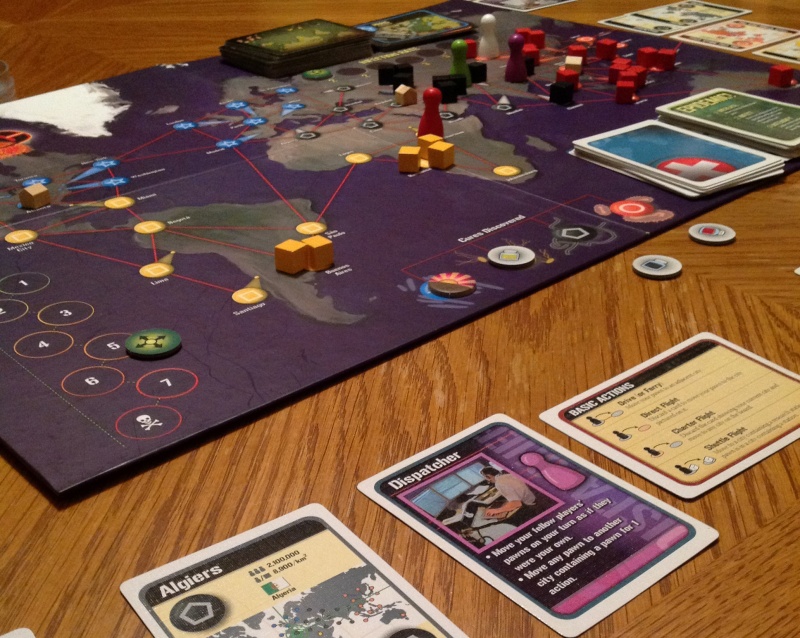
Game Experience:
Pandemic was my first cooperative game. I had always played games where there was one clear winner and the thought of playing a game that we either all win or all lose was intriguing. It’s a blast playing together in co-op games. I have found that this genre is one that I will play any time the opportunity arises. Playing as a team, working together, and dealing with crisis makes co-op games exciting. However, just because a game is co-op doesn’t mean it’s a good one. Luckily for you, Pandemic is a great one.
Pandemic is just a blast to play. With everyone throwing out opinions on what players should do on their turn and trying to decide the best course of action there is plenty of discussion during the game. There is also the potential issue with one person becoming the leader and making the decisions for everyone’s turn, but in my experience, I have found that people have worked together to win the game.
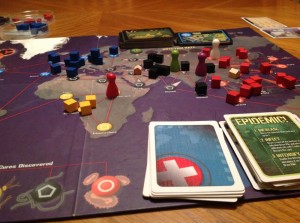
Every time you play this game, it’s different. Different areas are infected, you play a different role, and the epidemic cards all add to the replay value of the game. This is something I value highly because some co-op games can become stale and repetitive. I think this is the defining factor in why I like this game as much as I do. You never know what to expect and just when you think you have things under control, the game bites back. And when it does, it bites back hard. Which brings me to one thing you should know about this game, it’s the hardest game to win I have ever played and yet I have played it over 25 times.
Pandemic is relentless in its assault against the players. Each player’s turn is spent trying to put out the fires that were started during the previous player’s infector phase. Even after a player will take all their actions to contain an outbreak, they still have to infect another couple of cities so there is no break in the action. When I say this game is hard, I’m not kidding. I have won maybe 15% of the games I have played. Pandemic will sometimes lure you into a false sense of security before turning around and punching you in the face. Players must absolutely work together to cure these diseases. Despite my shoddy win percentage, it is the experience of trying to save the world that keeps me coming back. I have never had so much fun losing a game so much. But when we win, it’s usually a triumph worth remembering.
This game hits it out of the park with thematic synergy with the game. There is something extremely satisfying seeing the disease start to strengthen and you and your team swoop in to stop it. You feel like the world is crumbling and you are the only ones who can save it. In most games, your back is up against a wall for most of the game. Those are the times when a win against the game feels to delicious. When a game is able to do that, it can draw you in and make each game a memorable experience.
Final Thoughts:
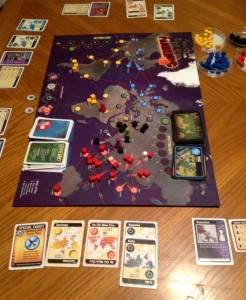
I feel that Pandemic is a game that you need to play to appreciate. There is tons of complexity and variability that just makes this game a joy to play. The complexity lies in the strategies needed to win. The game itself is actually fairly easy to learn. I have played with plenty of non-gamer friends and no one had any issues picking up the game. The turn actions are simple and intuitive. And with a play time of about an hour (or less if you are unlucky), you can get in a couple of games in a row if you keep losing (or winning even). And Pandemic will have you coming back for more, believe me. It will punch you in the gut and you will thank it and ask for another. I’m hard pressed to think of a game I lose so much but enjoy to an equal amount.
So yeah, the components could have been improved and the game is incredibly difficult to win, but that shouldn’t turn you away from this game. Every time you play, you feel the stress of the game pressing down on you. Feeling that there is no chance for survival, but still you press on. That’s a great thing for a coop game to have. If the game is too easy, the players won’t get the sense of accomplishment for winning. Since there is no opposing player, a coop game has to be very well made to keep it balanced. If there is one thing that Pandemic is, it’s well made. Between the immersive theme, the increasing difficulty and the demanding teamwork, Pandemic is hands down one of the best cooperative games on the market today.
If you want to have a good time with friends in a game type that non-gamers haven’t experienced, try Pandemic. Saving the world has never been so much fun.
If you are interested in getting a copy for yourself, it’s about $35.
Final Score: 5 Stars – A great co-op game that is challenging, but so much fun, that you will come back for more.
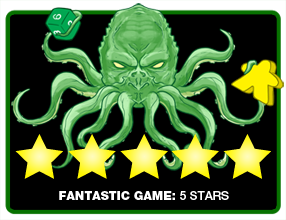 Hits:
Hits:
• Variability in game play
• Great connection to the theme of the game
• No drop of tenseness during game play
• Demanding teamwork
• Strategic game play with easy to learn rules
Misses:
• Use of generic cubes for disease
• Game is very difficult to defeat





















I have to agree with you this game is very fun and very challenging.
Pandemic is one of the most well designed coop games out there. After playing Pandemic many times I purchased Forbidden Island, another coop game by the same designer. It’s quite a bit easier, and with less components better for the inexperienced gamer.
I am glad I caught this review as I am a big can of coop in general. There aren’t a ton of titles out there that allow that sort of game play so I could see this being a hit in my gaming group.
I’m not super psyched by the setting but there are trade offs. Great review, thanks!
How old do you need to be to play the game? Is it too difficult for a 8 yr old who is quite smart? The kids and parents play games together all the time. Thanks